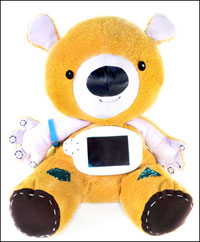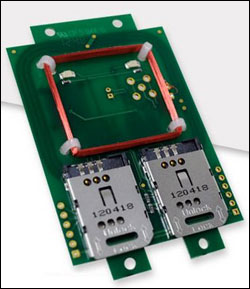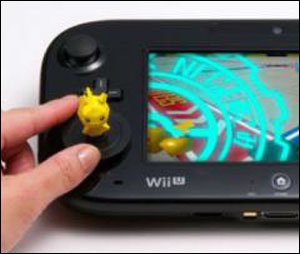The following are news announcements made during the past week by the following organizations: Sproutel; Tap For Message; Acura Global; Dwinq; Lexus; MicroGen Systems; the Rochester Institute of Technology; and Nintendo.
Sproutel’s RFID-enabled Bear Helps Kids Cope With Type-1 Diabetes
Startup Sproutel, which manufactures interactive games for children with chronic illnesses, has introduced Jerry the Bear, a stuffed bear that features a touchscreen, sensors and RFID technology—all in an effort to help children better understand and manage their Type 1 diabetes. The toy bear helps kids manage carbohydrate counting, identify symptoms and learn how to respond to hypoglycemic events. The touchscreen—known as Jerry’s Glucopal—is embedded in the bear’s belly, and shows videos and displays messages. For example, Jerry tells children when his blood sugar is low, and what food he should eat. RFID-tagged food, which comes with the bear, can be fed to Jerry, and as that happens, the tag is interrogated by a small reader in Jerry the Bear’s mouth. Once the RFID foods are recognized, they begin popping up on a virtual plate on Jerry’s Glucopal screen. “Children feed Jerry to help manage his glucose levels by tapping the foods on Jerry’s mouth,” says Aaron Horowitz, Sproutel’s CEO, who founded the company with Hannah Chung. “Each food has a different carb value, and thus helps children learn how to plan out meals and correlate carbs to insulin.” For the RFID capability, Sproutel is using RFID technology produced by Winbond Electronics Corp., headquartered in Taiwan—specifically, the company’s Winbond W55MID15 passive 13.56 MHz read-only RFID tags and corresponding Winbond W55MID50 reader. The W55MID15 is part of Winbond’s WinRF family of products focused on toy- and consumer-related applications. The W55MID15 tag is available with 243 different 10-bit ID numbers, encoded during manufacture. In addition to the RFID-enabled food cards, Jerry the Bear also comes with an insulin pen, while sensors in his legs, arms and buttocks detect the injections once the insulin pen is placed near them. The bear also comes with a backpack. Available now in the United States, Jerry the Bear costs $249, including free software upgrades. According to Horowitz, the company is presently working on new ideas for other RFID-enabled accessories that can better connect objects in the physical world to virtual objects on Jerry’s screen. “These are still in the works,” he states, “so stay tuned.”
Tap For Message Technology Puts NFC in Greeting Cards, Invitations and More
Tap For Message, a startup in New Jersey, has unveiled its new Near Field Communication (NFC) service that allows users to attach a card, sticker or hangtag to a gift, invitation or other physical object, in order to deliver an audio or video greeting. The company’s service can also be used for event management. The cards, stickers and hangtags each have an embedded NXP Semiconductors‘ NTAG203 chip, compliant with the NFC Forum‘s Type 2 standard, and offering 144 bytes of user memory. To set up a video or audio greeting to be delivered with a card, invitation or gift, a customer taps his or her NFC-enabled smart phone on the NFC tag (there is also a QR code and a URL that can be used to create a video or audio message). Once at the Tap For Message Web site, the customer clicks the Activate Greeting button, enters an activation code printed on the back of the sticker and follows the instructions to select a pre-recorded video, or to record a personal video on the fly, using the smartphone. He or she clicks another button to activate the message, and the card, sticker or hangtag, is then ready for use. The person who receives the card or sticker simply taps his or her smartphone to the tag to begin watching or listening to the personalized video or audio. A couple can create personalized wedding invitations that include a video and a customized RSVP, so guests can respond right from their smartphones and the couple can immediately keep track of who is coming, according to Kadeer Beg, Tap For Message’s CEO, who founded the company with his brother, Ahmer. The wedding couple can also add additional information to the invitation, including a bridal registry. “This makes event planning very easy, because you can customize the form and the message that is delivered,” Beg says, adding that the NFC-enabled solution can also be utilized for corporate events, or by salespeople looking to send customized messages to their clients. “This type of communication becomes much more memorable for their customers,” he states. The stickers can be affixed to greeting cards or gifts, and the hangtags can be affixed to a variety of items, such as a bouquet of flowers. The various cards (which are about the size of a credit card) and hangtags are available as paper-based products, but are also available as plastic-coated cards. Pricing varies; the PVC-coated card is available for $6.99. According to the company, Tap For Message was the finalist at this year’s National Stationery Show, held in New York City, for Best New Product. The video greeting products can be purchased now at the Tap For Message e-commerce store or Facebook page, and is slated to be available at retail and other online stores later this year.
Acura Global Intros New RFID NFC Reader Module
Acura Global, a Brazilian provider of RFID technology, has announced a new RFID reader module designed for original equipment manufacturers (OEMs) that supports the reading and writing of tags in various frequencies. It supports 125 kHz, 134.2 kHz and 13.56 MHz frequencies, and supports all major transponders from various distributors, including Atmel, EM Microelectronic, STMicroelectronics, NXP Semiconductors, Texas Instruments, HID Global, Legic and Inside Secure (formerly known as Inside Contactless). The reader module supports a variety of standards, including ISO 14443A/B, ISO 15693 and ISO 18092 Near Field Communication (NFC), and is available in three versions. The NFC version, known as NFC-P, comes with support for proximity tags, while the NFC-PI includes support for proximity tags and HID iClass (read-write) tags. All three versions feature the same dimensions, measuring 76 millimeters by 49 millimeters by 12 millimeters (3 inches by 1.9 inches by 0.5 inch) and weighing 20 grams (0.7 ounce). Communication interfaces supported include USB, RS-232 and TTL.
Dwinq’s RFID Solution Helps Lexus Reach Social Media During U.S. Open
During three events at this year’s U.S. Open golf championship, luxury-car maker Lexus leveraged an RFID-enabled solution from Dwinq to let attendees interact, play online games and watch videos on Facebook, Twitter, YouTube and other social-media sites. Dwinq, an RFID and social-media company based in Cambridge, Mass., calls its solution a “social-media operating system,” comprising software, passive ultrahigh-frequency (UHF) RFID-enabled ID cards from Vanguard ID Systems, and a combination of readers from different vendors to interrogate those tags. Hundreds of guests at the golf courses who visited the Lexus Performance Drive Pavilion automatically shared their experiences with their social-media friends and followers via the Dwinq platform, which can immediately transmit photographs, onsite activations and real-time videos to the Facebook pages, Twitter feeds and YouTube accounts of those attendees who opt in to the system. U.S. Open attendees were given the ID cards at the Lexus pavilion, which they signed up for and activated on an Apple iPad. That data was then linked to the unique ID number encoded to their badge’s RFID tag. Various stations contained kiosks for interactive games, a photo booth and a swing simulator, and at each station, a reader collected the tag IDs and other data related to the event, which was then forwarded to the user’s selected social network. The engaging activations for the U.S. Open were created by Lexus’ agency of record, Team One, located in El Segundo, Calif. Dwinq partnered with Lexus on a similar offering at last year’s U.S. Open, and has also worked with other companies for similar social-media initiatives (see Nissan Europe Uses RFID-enabled Social Media to Drive Consumer Interest and Cadbury Offers RFID-enabled Treats During Summer Olympics).
MicroGen Powers Wireless Sensor Network at Rochester Institute of Technology
MicroGen Systems (MicroGen), a manufacturer of piezoelectric microelectromechanical systems (piezo-MEMS), has announced that it is testing its vibrational energy harvesters or micro-power generators (MPG) in partnership with the Facilities Management Services department of Rochester Institute of Technology (RIT). MicroGen installed its harvesters on the RIT campus to monitor a wireless sensor network (WSN), and to measure temperatures on exhaust and air-handling equipment operating within RIT’s Science Building. MicroGen’s MEMS technology is designed to capture and store energy for WSNs. MEMS—small silicon chips that can combine mechanical elements, sensors, actuators and electronics—have been used for several decades, in everything from inkjet printers to accelerometers that deploy air bags in cars (see RFID News Roundup: MicroGen Gets Funding for MEMS-based Energy Harvester). According to MicroGen, its BOLT power cells were mounted on various exhaust fans and blowers that exhibited a range of vibrational frequencies. BOLT power cells are 3.3-volt DC power sources, which contain a piezo-MEMS energy harvester, AC to DC conversion electronics, and a small amount of capacitive energy storage. They are intended to replace or supplement batteries, the company reports, providing at least 100 microwatts to 1.0 milliwatt at frequencies ranging between 100 Hz and 1500 Hz at low acceleration levels greater than or equal to 0.1 g. At RIT, the power cells were used for five weeks to enable Texas Instruments‘ eZ430 wireless sensor motes in a WSN. In addition, temperatures were monitored. “This type of installation using wireless sensors and vibrational energy harvesting provides the flexibility for existing buildings to quickly implement a sensing system for monitoring building performance, which will help in energy conservation and maintenance costs,” said Catherine Ahern, an RIT adjunct professor who also serves as the director of engineering services in the university’s Facilities Management Services organization. “Coupling the MicroGen’s BOLT energy harvesting technology with the wireless motes also will be much less expensive than wired solutions in installation.” MicroGen will leave a subset of the self-powered wireless sensors in place for continued analysis and study indefinitely, the company indicates. A similar TI mote-based WSN was set up in early June at the Sensors Expo, held in Rosemont, Ill. MicroGen completed this project as part of a NY State Energy Research Development Authority (NYSERDA) commercialization contract award (see MicroGen Gets Funding for MEMS-based Energy Harvester).
Nintendo to Begin Selling NFC-enabled Pokémon Figurines for the Wii U
Video game purveyor GameStop will begin selling Nintendo‘s Pokémon figurines embedded with Near Field Communication (NFC) tags for the Wii U in the United States on Aug. 29, according to the Pokémon Web site. The NFC figurines will work with a new game in the Pokémon Rumble series, known as Pokémon Rumble U, which utilizes the features of the Nintendo Wii U system, including the NFC RFID reader to the game’s controller. When announced in February 2012 (see RFID News Roundup: Nintendo to Add NFC to Wii U Controller), Nintendo’s president, Satoru Iwata, said the NFC functionality would enable the creation of “cards and figurines that can electronically read and write data via noncontact NFC, and to expand the new play format in the video-game world. Adoption of this functionality will enable various other possibilities, such as using it as a means of making micropayments.” The forthcoming NFC-enabled Pokémon figurines have NFC bases that can be placed on the NFC reader at the bottom-left of the Wii U controller, which interrogates each figurine’s statistics and abilities, and then places that character in the game.





